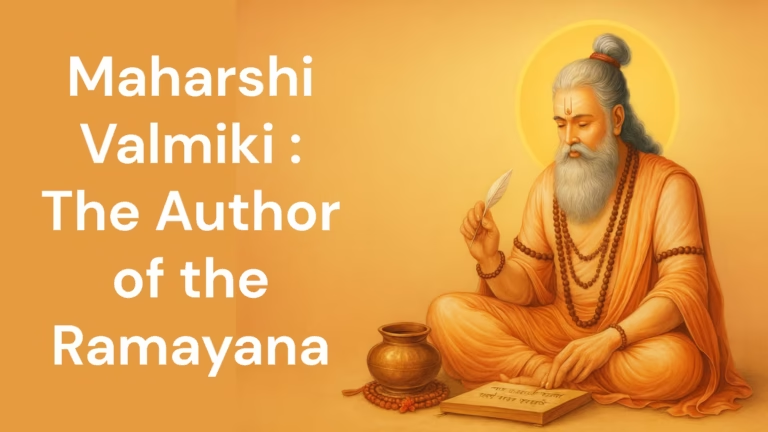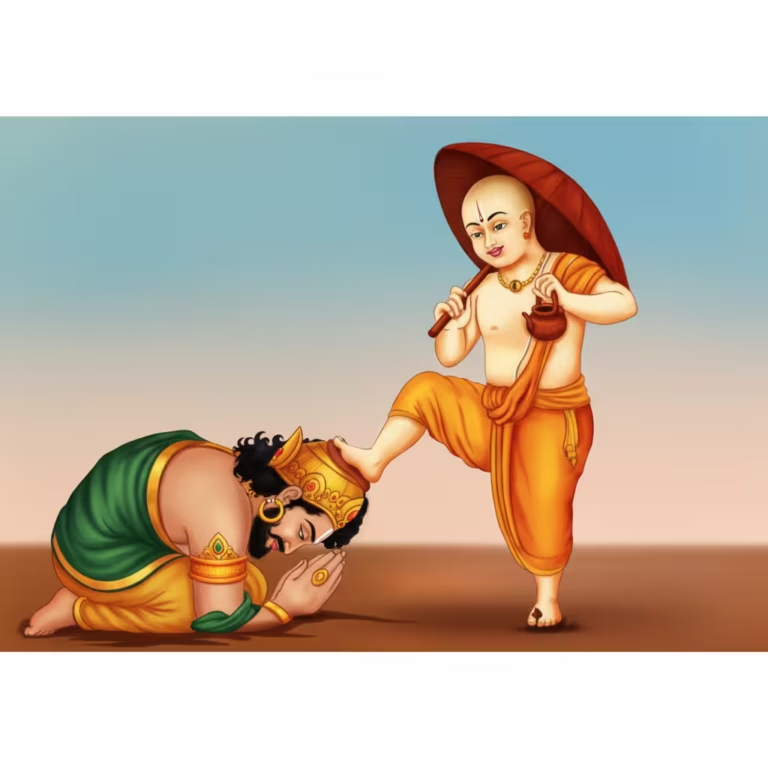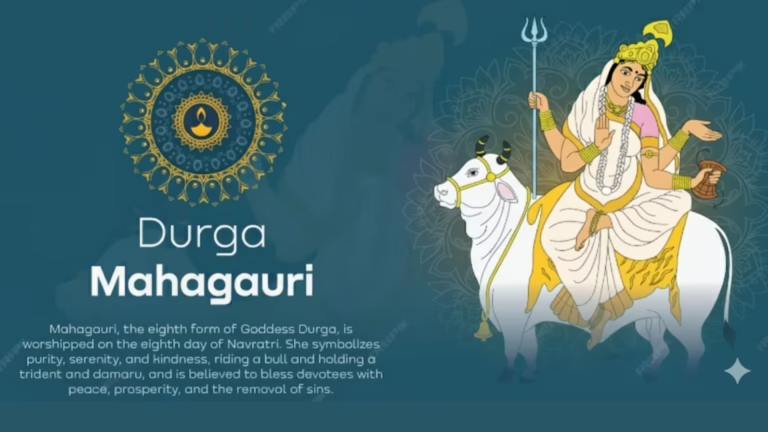As the ninth worshipped form in the Navadurga tradition, Maa Siddhidatri embodies the grace‑stream of Shakti that bestows siddhi—that is, spiritual/yogic prowess and inner strength—upon the seeker. Within the Shakta stream, descriptions of the primordial Divine Mother’s many manifestations appear in the Devi‑Mahatmya (of the Markandeya‑Purana lineage) and the Devi‑Bhagavata Purana. Affirmed by these scriptural currents, Siddhidatri is revered as the final, consummating form in the Navadurga sequence, where the seeker gathers purity, fortitude, heroism, and discernment received from the earlier forms and orients toward self‑completeness.
This Life‑Charit presents a Purana‑based exposition of Siddhidatri’s Name‑Etymology, Origin‑View, Form & Attributes, Doctrine of Siddhi, Scriptural Worship, Fruits of Sadhana, Dharma‑Ethic, and Place within the Navadurga Order, so that the reader gains scripturally sound, fact‑aware, and practical understanding in one place.
Name‑Etymology and Purport
“Siddhidatri” is a compound of two words: siddhi and datri. Siddhi means attainment, accomplished state, or an effortless capability/excellence that ripens through sadhana and divine grace; datri means the giver. Thus, Siddhidatri is the Goddess who bestows siddhi upon the seeker.
In the Purana tradition, siddhi does not merely denote wondrous operative powers; it also signifies dharma‑aligned inner strength and the light of discernment (viveka) by which the mind becomes steady and action comes under the discipline of dharma. Therefore, the Siddhidatri principle keeps sadhana purposeful and restrained—where siddhi is not the end of practice but a means for upholding dharma.
See also: Maa Shailaputri – Life‑Charit (Purana‑Based)
Origin‑View: Harmonizing Devi‑Tattva and Siddhi
The Puranas accept the Primordial Power (Adi‑Shakti) as the Supreme’s Mahamaya, the mover of creation, preservation, and dissolution. In the Devi‑Mahatmya, to the devatas’ hymns, the Goddess manifests in various gentle and fierce forms to curb adharma and protect the devotees. The Devi‑Bhagavata Purana gives broad expositions on Shakti‑tattva, modes of worship, and fruits of sadhana.
Within this wide scriptural horizon, Siddhidatri images the coordination of grace and effort. Here, siddhi is not merely operational prowess but an inner heroism that purifies tendencies and culminates in dharma‑true action. The Purana standpoint concludes that divine boons are auspicious only when they safeguard purity of conduct and discernment.
Form‑Description: Emblems, Vehicle, and Traits
Hymnic and iconographic traditions describe Siddhidatri’s form as gentle and grace‑bestowing. Accounts differ regarding the number of arms, emblems, or vehicle; scripturally the import is to signal dimensions of action, not fixate on counts. The commonly remembered traits include:
- Seat (Asana): often a lotus throne, symbolizing purity and grace.
- Hand Gestures (Mudras): Varada (boon‑granting) and Abhaya (fear‑dispelling).
- Emblems/Marks: shankha (conservation and rhythm of time), chakra (discriminative order), gada (steadfast courage), lotus/rosary, and scripture/book (knowledge)—standing for nurture, time‑wisdom, patience, and insight.
- Vehicle: traditions remember the lion, the timeless emblem of fearlessness.
- Nimbus (Prabha‑mandala): a serene radiance, the figure of inner viveka.
The intent of form‑description is that each emblem of Siddhidatri implants patience, cheerfulness, discernment, and fearlessness in the seeker—the true aim of siddhi.
The Doctrine of Siddhi: A Purana View
References to siddhi occur at many points in the Purana corpus. The Bhagavata Purana (notably the Eleventh Skandha) discusses yogic accomplishments and the effects of devotion, where the union of divine grace and sustained practice flowers into remarkable fortitude, discernment, self‑mastery, and a public‑spirited bent of action. In the Shakta stream, the Siddhidatri principle means that by the Goddess’s grace the seeker receives righteously governed siddhi, always exercised within restraint and decorum.
The Puranas primarily urge observance of dharma; hence siddhi must not serve showmanship or adharma, but self‑cultivation and the welfare of society. This is the central message of the Siddhidatri doctrine.
Divine Acts (Lila): Grace with Restraint
In the narrative flow of the Devi‑Mahatmya, the Goddess arises in diverse forms to subdue the wicked and protect the devoted; this balance also appears in Siddhidatri’s grace. Here, grace signifies the measured bestowal of siddhi—that which steadies the mind of the seeker and empowers duty‑observance.
The scriptural current concludes that the aim of the Goddess’s grace is to strengthen right order (loka‑vyavastha). Hence, the pursuit of siddhi must not turn into self‑display or misuse—this wise restraint is the true ornament of a devotee’s life.
Scriptural Worship: Core Injunctions and Decorum
Shakti‑worship rests upon mantra, meditation, hymnic recitation, and purity of conduct. In the Navadurga tradition, Siddhidatri is worshipped on the ninth day/culmination. Scriptural priorities include:
- Purity and Resolve: truth, non‑violence, restraint; sattvic food; purity in thought, speech, and act.
- Recitation Traditions: reading the Devi‑Mahatmya (Durga‑Saptashati); Goddess hymns; guru‑initiated mantra‑japa under the preceptor’s direction.
- Meditation: contemplate the gentle form with varada/abhaya mudras, with the resolve that all siddhi shall remain under the rule of discernment.
- Invocations, Offerings, Lamp‑worship: always within scriptural bounds; avoid ostentation—inner purity is paramount.
The Puranic insistence is that the marrow of worship is purity of conduct; outer observances yield fruit when inner practice is firm.
Fruits of Sadhana: Scriptural Assurances
The promised fruits of Siddhidatri worship are chiefly inner stability and the light of discernment. The traditional list includes:
- Tranquility and Cheer: dissolution of fear/doubt; mental balance and gracefulness.
- Discernment and Restraint: dharma‑true decision‑power; self‑control in conditions.
- Energy for Action: overcoming sloth/inertia; diligence and time‑sense.
- Removal of Obstacles: victory over inner/outer impediments; continuity in practice.
- Public‑spirited Disposition: moving beyond private attainments toward service of family and society; upholding justice and compassion.
These fruits endure when practice is regular, scripture‑aligned, and guru‑guided.
Place of Siddhidatri within the Navadurga Order
Navadurga—nine worshipful dimensions of Shakti—lead the seeker sequentially toward purity, austerity, valor, creative awareness, motherly compassion, heroic vigor, dispelling of darkness, the grace of purification, and finally, integration through siddhi. In this sequence, the ninth—Siddhidatri—represents consummation and coordination: the earlier samskaras—valor, compassion, discernment, peace—now converge as discernment‑governed siddhi, guiding the seeker toward self‑completeness.
Fine differences of daily sequences/ritual programs depend upon specific teacher‑lineages; the scriptural gist—integration in the Goddess—remains unchanged.
Dharma‑Ethic: The Restrained Use of Siddhi
The practical teaching of the Siddhidatri principle is that siddhi implies not entitlement but responsibility. Three canons of dharma‑ethic:
- Self‑governance: mastery over tendencies; quieting of sense‑attachments and ego.
- Justice‑driven Action: employ strength/resources/skills only for dharma‑supporting ends.
- Public Service: protect, educate, cooperate, and uphold justice within family and society—this is the loftiest use of siddhi.
Such restrained use makes siddhi auspicious; otherwise, it can lead the seeker toward restlessness—the Puranas counsel exactly this caution.
What Not to Do in Purana‑Based Worship
- Non‑scriptural Methods: do not attempt esoteric mantra‑rites/tantric procedures without initiation and preceptor’s guidance.
- Ostentation: prioritise purity, truth, and compassion over display or luxury.
- Unsupported Claims: avoid asserting what lacks clear textual basis; first seek scriptural proof.
Frequently Asked Questions (FAQ)
Is Siddhidatri explicitly mentioned in the Puranas?
The gentle and fear‑dispelling forms of Shakti and the flow of Navadurga worship are affirmed by the Devi‑Mahatmya (Markandeya‑Purana lineage) and the Devi‑Bhagavata Purana. The ninth Navadurga form—“Siddhidatri”—is established as a derived/coordinate worship‑image emerging from these scriptural streams.
What is the scriptural sense of siddhi?
From the Purana perspective, siddhi is not merely startling feats; it is governed inner prowess and light of discernment. The Bhagavata Purana treats yogic attainments and the effects of devotion as the union of practice and divine grace—the aim remaining the observance of dharma.
Are the number of arms/emblems/vehicle fixed?
Hymnic and iconographic traditions vary; the scriptural intent is education in action‑dimensions, not fixation on counts.
Is there any mandatory mantra/fasting rule?
The safe, scriptural path comprises Devi‑Mahatmya recitation, Goddess hymns, and guru‑initiated mantra‑japa. Counts/nyasa/ritual details must always follow the preceptor’s instruction.
Didactic Message: The Character of Siddhi
The Siddhidatri principle teaches that the noblest use of siddhi is self‑purification and public welfare. When siddhi remains under the discipline of discernment, it becomes the consummation of sadhana; otherwise, it may become a cause of deviation. Hence a pure heart, restraint, and fidelity to dharma—this is the character of true siddhi.
Maa Siddhidatri thus implants the samskara of discernment‑ruled accomplishment in the seeker’s life. In the Devi‑Mahatmya and Devi‑Bhagavata lineages, the final aim of the Navadurga sequence is self‑completeness and the establishment of dharma—and Siddhidatri is its gentle, grace‑laden, decorum‑safeguarding form. The essence of worship is a pure heart, scriptural recitation, and the guru’s directive—this path grants long‑term peace, stability, and meaningfulness.
Related reading: Maa Shailaputri – Life‑Charit (Purana‑Based)
Maa Siddhidatri – Book: https://amzn.to/3IKvsBK



